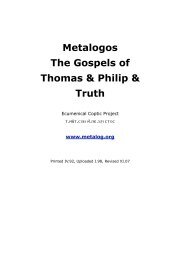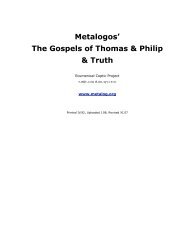Andrew Louth - Syriac Christian Church
Andrew Louth - Syriac Christian Church
Andrew Louth - Syriac Christian Church
Create successful ePaper yourself
Turn your PDF publications into a flip-book with our unique Google optimized e-Paper software.
92 DIFFICULTY 10<br />
veil describes for Maximus the experience of engagement with all that<br />
hides God: in short, it describes the experience of ascetic struggle.<br />
Maximus explores this in the first sections, as he discusses how the<br />
soul operates and of what its relationship to the body consists<br />
(sections 1–3).<br />
But the ideas of contemplation and the cloud have already brought<br />
to Maximus’ mind the Transfiguration of Christ, when the disciples<br />
beheld the radiant glory of the divinity of their Lord, and a bright<br />
cloud overshadowed Him (see Matt. 17:1–8 and parallels). In the<br />
account of the Transfiguration (and in icons, too: the earliest known<br />
icon of the Transfiguration is from about the time of Maximus’ birth;<br />
it is still in the monastery of St Catherine at Sinai), Christ appears<br />
transfigured together with the figures of the great prophets of the Old<br />
Testament, Moses and Elijah. In this event the Old and the New<br />
Testaments meet: the prophets bear witness to Christ’s glory, which is<br />
beheld by the apostles. It is the Transfiguration, and all that it<br />
implies, that is at the heart of Maximus’ tenth Difficulty. At the end of<br />
section 3, in his account of how the soul, having passed beyond the<br />
cloud, escapes to intellectual contemplation, Maximus recalls the<br />
place of the cloud in the escape, under Moses’ leadership, of the people<br />
of Israel from Egypt, and this leads to a long series of meditations (or<br />
contemplations) on events from the Old Testament concerned with<br />
passing over, or passing beyond—to contemplation of God. Here we<br />
encounter quite directly the lateral movement of Maximus’ mind.<br />
Thirteen short sections (sections 4–16) explore the preparation in the<br />
Old Testament for the divine manifestation of the Transfiguration<br />
(section 17).<br />
In the Transfiguration itself we behold, not just Christ<br />
transfigured, but also his garments which contain his human<br />
presence. These garments can be interpreted either as Scripture or as<br />
the works of creation: a dual interpretation Maximus sees indicated in<br />
the two figures Moses (who received the written law, already<br />
discussed in section 5) and Elijah (to whom God revealed himself<br />
through the works of creation: 3 Kgd 19:9ff., already discussed in<br />
section 12). This leads Maximus to demonstrate the unity of the<br />
natural and the written law (section 18), and then, in section 19, to<br />
discuss natural contemplation, the contemplation of God in created<br />
nature (in this section, in particular, he picks up and corrects some<br />
Origenist errors concerning the cosmos). All this is explored in a long<br />
series of meditations, especially of Melchisedec (the priest-king of<br />
Salem of Genesis 14:18–20, whose superiority to Abraham<br />
demonstrates his transcendence of the written law, as Heb. 7 argues)<br />
and Moses. Section 31 returns to the Transfiguration itself, with a<br />
series of brief meditations, which include a striking Christological




